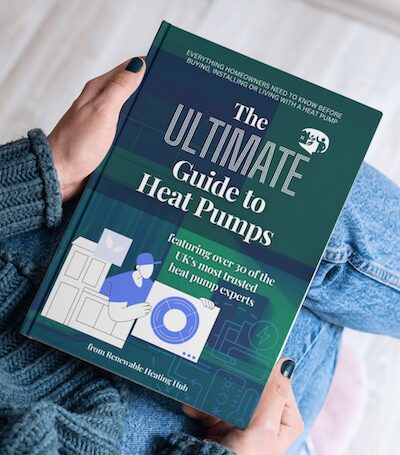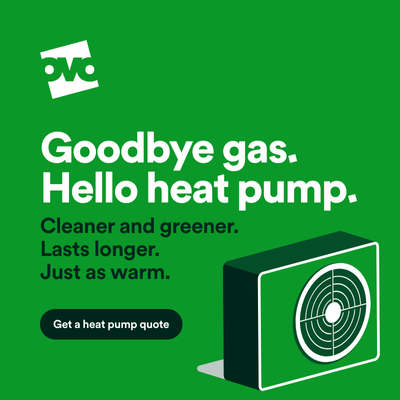HP Cycling, Expected or Undesirable
After upgrading the insulation and radiators in my living room, the cool Summer has given me the opportunity to see what effect this has had on my heat pump. Initial results were excellent with me dropping the lower end of my WC curve by 6 degrees C, however now I have hit the point where I am seeing cycling as the pump cant get rid of enough heat. The graph from this morning shows this clearly.
Its obviously a nice problem to have and the COP is very high, but is this cycling too much? Would I be better raising the flow temperature to try and stop it or will the scroll compressor cope? The temperature in the living room hit 24C before I turned the heating off, so there is an opportunity to lower the flow temperature even more.
Opinions please?
House-2 bed partial stone bungalow, 5kW Samsung Gen 6 ASHP (Self install)
6.9 kWp of PV
5kWh DC coupled battery
Blog: https://thegreeningofrosecottage.weebly.com/
Heatpump Stats: http://heatpumpmonitor.org/system/view?id=60
One way to try to reduce cycling frequency would be to raise the Leaving Water Temperature (LWT) by means of the Weather Compensation (WC) offset. This should in turn cause the Indoor Air Temperature (IAT) to be increased, which in turn should increase the actual heat loss, thereby putting more loading on the heat pump.
A further benefit of raising the IAT during the milder period of the day, when the heat pump should operate more efficiently, is that it will likely reduce the loading on the heat pump during the cooler period of the day when the heat pump will operate less efficiently.
The WC offset should be removed during the peak demand period, since it will likely reduce the need for the heat pump to operate.
@derek-m Thanks Derek, I appreciate that raising the flow temperature (via the WC curve) will reduce the cycling, but at the expense of reducing the COP too.
I guess what Im asking is will this level of cycling likely cause damage the compressor over time?
As an aside I have turned on a radiator in an unused bedroom to see if that helps and in the future there will be an extension with extra radiators to again increase the heat load.
House-2 bed partial stone bungalow, 5kW Samsung Gen 6 ASHP (Self install)
6.9 kWp of PV
5kWh DC coupled battery
Blog: https://thegreeningofrosecottage.weebly.com/
Heatpump Stats: http://heatpumpmonitor.org/system/view?id=60
I would agree that increasing the LWT is likely to reduce the instantaneous COP value when the heat pump is operating in continuous mode, but it may not reduce the overall COP when the heat pump is cycling.
I have an Air to Air (A2A) heat pump that I normally operate using solar PV generation, so free heating. When it first starts up it operates for several minutes in low power mode drawing a reduced amount of electrical energy, which I assume is because the compressor output pressure is still quite low. As the pressure starts to rise so does the loading on the electrical supply, all of this before any thermal energy is emitted from the indoor unit. The system is therefore operating with a negative COP until it starts pushing thermal energy into our home. By raising the IAT during the daytime, we don't require any further heating during the nighttime period.
Raising the LWT should reduce the cycling frequency, thereby reducing the number of stops and starts of the compressor, which may actually improve overall efficiency.
I do believe that I am correct in saying that a compressor contains some lubricating oil, which is dispersed around the moving parts when the compressor is operating. I suspect that when the compressor first starts to operate, not all the moving parts may be fully lubricated, so by reducing the number of compressor starts it is likely that less wear will occur.
By raising the IAT by 1C or 2C during the mid to late morning period and the mid afternoon period, you may find that it not only reduces the number of stops and starts of the compressor, but may also increase the overall efficiency, even if the COP value may indicate otherwise.
You have very little to lose by giving it a try.
@derek-m Thanks again. I seem to be on the cusp of the flow temperature that initiates the cycling at these outside temperature so as you say its probably best to err on the safe side even it it might reduce COP by increasing it a tad. 🙂
House-2 bed partial stone bungalow, 5kW Samsung Gen 6 ASHP (Self install)
6.9 kWp of PV
5kWh DC coupled battery
Blog: https://thegreeningofrosecottage.weebly.com/
Heatpump Stats: http://heatpumpmonitor.org/system/view?id=60
@derek-m I will post again in a few days after experimenting 🙂
House-2 bed partial stone bungalow, 5kW Samsung Gen 6 ASHP (Self install)
6.9 kWp of PV
5kWh DC coupled battery
Blog: https://thegreeningofrosecottage.weebly.com/
Heatpump Stats: http://heatpumpmonitor.org/system/view?id=60
I have been playing with this myself. LWT from the heat pump is controlled a couple of parameters. To start the heat pump the LWT has to be set delta temperature below target flow temperature. To stop the heat cycle it has to be a set delta temperature above target.
So as a practical example
Target flow temp is 30. Once the water flowing through the heat pump reduces to 22 degs (8 Deg delta) the heat pump starts. Once the flow temp increases to 31 (1 degree delta) the heating cycle stops. This process repeats.
What nearly always occurs when leaving the factory the delta setting are set too tight. Mine were 7 degs below target for start up and 0.2 above target to stop.
So to extend the run time and off time you need to extend the shutdown delta, I just set mine to 4 degs and the heat pump ran for 20+ mins before I shut it off. But you need to keep the target flow where it is or maybe lower it. So what you want is a slight yo-yo effect, slightly overheating then let the heating system cool, get heated. You then just need to compensate WC curve. A bit of fine tuning it should be unnoticed.
Finding the settings to change is the most difficult bit.
My run, data from the battery so is whole house. It's in 5 min snap shots, but you can see the drop in load at about 5 mins after it's hit target temp. Flow target was 27 degs, end temp when I shut down was 29.1.
@johnmo
You are perfectly correct that what I have previously described as the upper 'switch off' limit and the lower 'switch on' limit can indeed also affect the cycling frequency. How well these settings reduce cycling frequency depends upon a number of factors, where the LWT thermistor is located and how the water pump is operated along with the volume of water within the system.
If the thermistor is located on the pipework inside the heat pump unit, which itself is located outside, then the temperature may fall quicker than if it was located inside the home's thermal envelope.
A further factor is if the water pump continues to operate, is stopped along with the compressor, or operates intermittently. If water is still being circulated past the thermistor, it will likely cool at a slower rate and extend the switch off period, it should also extend the switch on period since the whole water system will have had longer to cool so take longer to heat back up.
If the water pump continues to run or operates intermittently, and the system has a larger volume of water then it is likely to cool at a slower rate, and since it being circulated past the thermistor will tend to keep it warmer, thereby extending the switch off period.
As you have stated for best operation it is necessary to understand how your system is designed to operate, what adjustments need to be made, and the best settings for optimum operation.
Posted by: @derek-mthermistor is located on the pipework inside the heat pump unit, which itself is located outside, then the temperature may fall quicker than if it was located inside the home's thermal envelope.
Mine is in the heat pump, so will be a little trial and error on the intermittent circulation compared to permanent circulation. We are heating thick concrete screed 190m² and 100mm deep, so cool down is pretty slow. But also heating a summer house via a fan coil effectively in the same zone. So adds a little complication. No buffer or volumiser all done from the heat pump circulation pump.
My heat pump has a buffer/flow temperature sensor inside the house. I don’t have a buffer so I just taped it with aluminium foil tape the the central heating flow pipe just after the 3 port. Covered it all in 19mm lagging.
My controller allows adjustment of the PID controller that adjusts the compressor/fan speeds. This needed tweaking in mine, along with the overshoot threshold to give headroom for the compressor to ramp down.
Pump runs whenever there is a call for heat. Compressor and fan cycle as required.
Im not too worried about cycling. The compressor in my fridge cycles, when was the last time a fridge compressor failed?
Off grid on the isle of purbeck
2.4kW solar, 15kWh Seplos Mason, Outback power systems 3kW inverter/charger, solid fuel heating with air/air for shoulder months, 10 acres of heathland/woods.
My wife’s house: 1946 3 bed end of terrace in Somerset, ASHP with rads + UFH, triple glazed, retrofit IWI in troublesome rooms, small rear extension.
- 26 Forums
- 2,356 Topics
- 53.4 K Posts
- 280 Online
- 6,017 Members
Join Us!
Worth Watching
Latest Posts
-
RE: Octopus Cosy Heat Pump Owners & Discussion Thread
@kevh with the Cosy 6 I know it definitely goes to arou...
By HarrisonC , 2 hours ago
-
RE: Setback savings - fact or fiction?
@cathoderay yes I am familiar with SQL. Interesting num...
By RobS , 3 hours ago
-

Parsnip, Bacon & Coconut Milk Soup
First let me say, I am only a cook because I am human a...
By Toodles , 4 hours ago
-

RE: Controlling Daikin Altherma via P1P2 and Home Assistant
@weoleyric Oh Dear, I don’t think I am going to be of m...
By Toodles , 4 hours ago
-
RE: Electricity price predictions
Ben Watts posted on LinkedIn that he had updated this w...
By Judith , 9 hours ago
-

RE: The good, the bad and the not that great – my heat pump installation
Small update, Emailed and Spoke to Midea UK and they ...
By Burtis , 10 hours ago
-
RE: Solis S6-EH1P8K-L-PLUS – Why I Chose It and What I’ve Learned So Far
@bash Octopus does charge for the admin. The process al...
By Batpred , 10 hours ago
-
RE: External pipework insulation
@transparent HI all The products you mention are ver...
By David Smith , 10 hours ago
-
RE: New Fogstar 15.5kWh upright solution
Issues still under investigation by Solis... Fogstar ...
By Batpred , 10 hours ago
-
RE: Who's your electricity provider and what's your tariff?
I agree, the consumer is not being properly represented...
By Batpred , 10 hours ago
-
RE: Advice on internal circulation pump noise
Thanks @mikefl - I'll maybe have a look at the lock-shi...
By jtg , 1 day ago
-

RE: Heat Pump Heats the House… But It’s Not Cosy. Emitter Changes or System Tweak?
@toodles interesting suggestion, thanks. I will try to...
By GrahamF , 1 day ago
-
RE: Mitsubishi Ecodan Auto Adaption trial to stop cycling.
The interval you talk of, i think, will be 60min for an...
By F1p , 1 day ago
-
Agree with @majordennisbloodnok on the setbacks. We hav...
By ChandyKris , 2 days ago
-

RE: Speedcomfort radiator fans
@deltona the way the links were added broke the page. A...
By Mars , 2 days ago
-

RE: Refrigerant R32, is it now banned in the EU from 1st Jan 2027 for monobloc ASHPs?
This has been delayed from what I believe to be this ye...
By dgclimatecontrol , 2 days ago
-
RE: Are We Sleepwalking Into Another Race to the Bottom?
this is why I provided current flow temperatures in the...
By ksim , 2 days ago
-

RE: Why Millions of UK Homes Struggle With Heat Pumps
There's many homes that would be quite a disruption for...
By dgclimatecontrol , 2 days ago
-
RE: Ecodan unable to hit legionella target temp - what's the consensus?
@rhh2348 ...maybe this option is what you want? Alter...
By benson , 2 days ago







